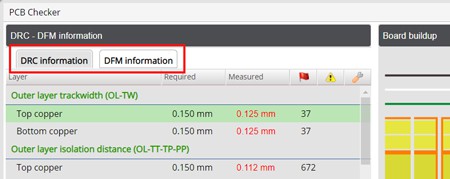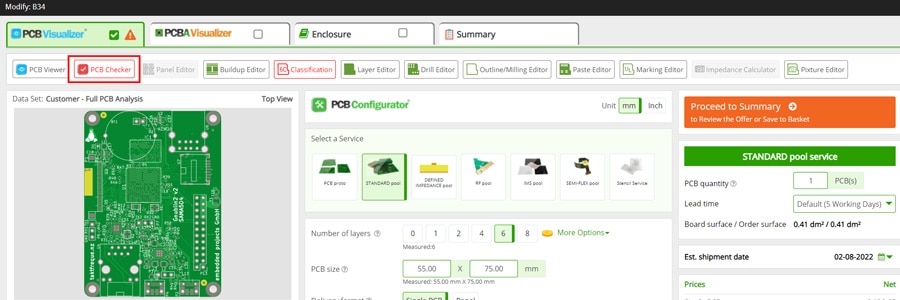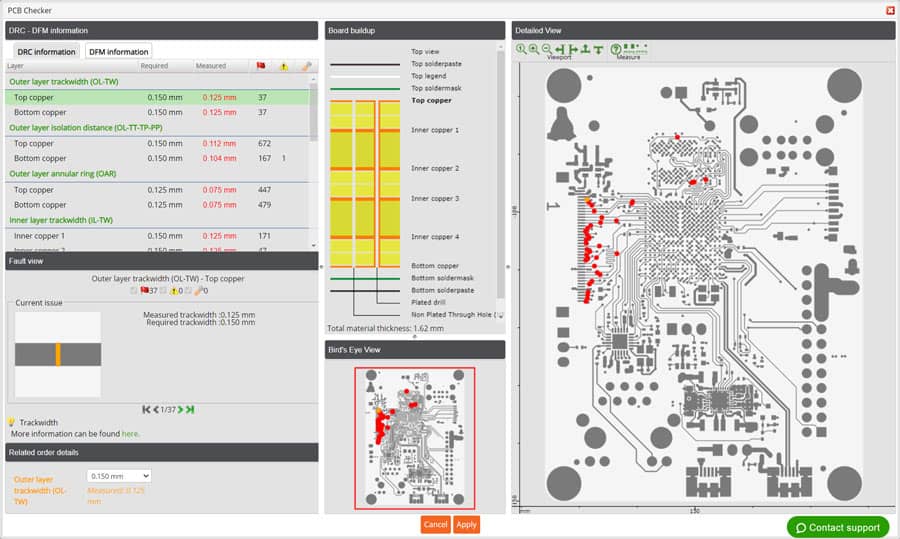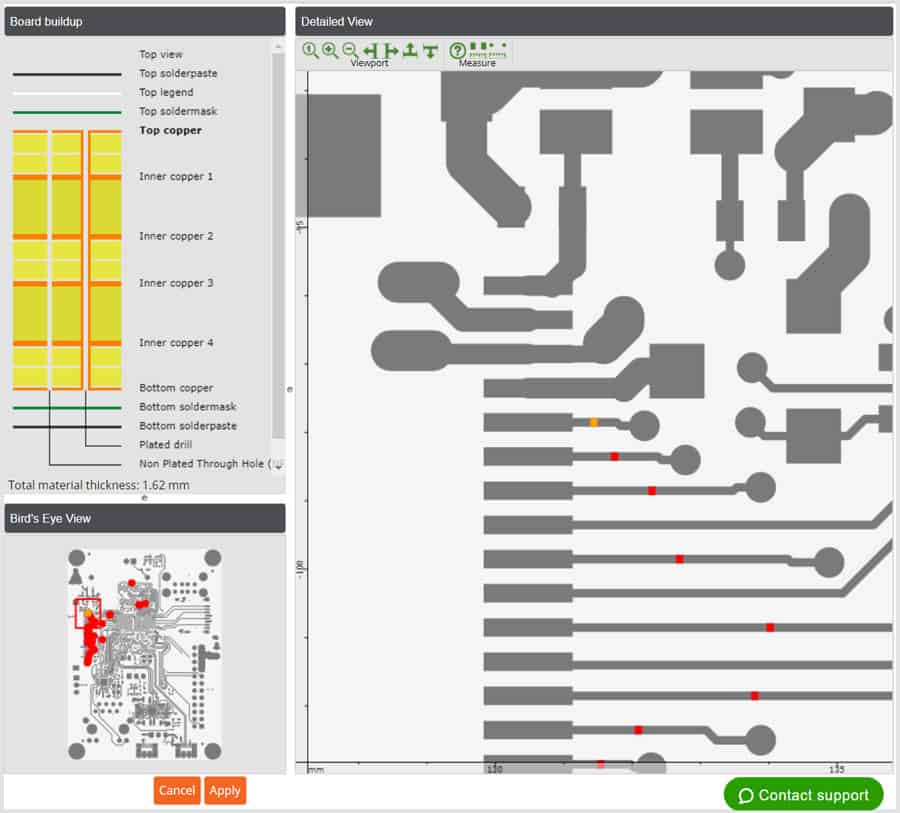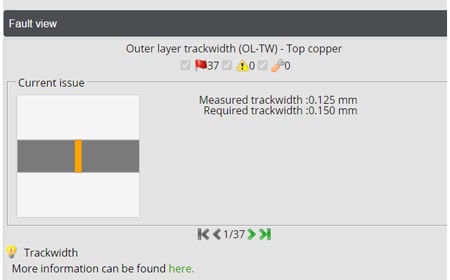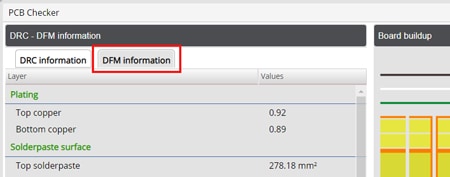PCB Checker User Guide
How to Use the PCB Checker |
|||||
DRC vs DFM information |
Opening the PCB Checker |
Reviewing the DRC information |
Resolving DRC Issues |
Reviewing the DFM information |
|
Introduction
The PCB Checker is part of the PCB Visualizer and allows you to verify the data uploaded and easily view any DRC (Design Rule Check) or DFM (Design For Manufacture) issues found during the analysis of the data.
IMPORTANT
The PCB Checker is only available after full analysis of the data has been completed and saved to the Shopping basket in your customer account. For more information, please see our How to Upload PCB Data User Guide.
DRC information vs DFM information
DRC information shows the results of the Full Analysis measurements against values set in the PCB Configurator (track width, isolation, annular ring etc.) and allows you to view any differences found one-by-one.
DFM information, also available after Full Analyses, shows information related to the PCB production process and relevant information for the Assembly process (Plating Index value, Copper surface (dm2) per layer, Solderpaste surface and Copper free of Soldermask, None connected pads free of soldermask that can be used as fiducial).
To view the DFM information simply click the DFM information tab in the DRC – DFM information section.
Opening the PCB Checker
Firstly, Sign in to your Eurocircuits User Account.
From the Shopping basket select the job you want to review and open the PCB Visualizer.
NOTE
- If there is no red flag (
 ) in the PCB Visualizer column, then there are no DRC or DFM issues that require your attention.
) in the PCB Visualizer column, then there are no DRC or DFM issues that require your attention.
The PCB Visualizer will open and next select the PCB Checker button from the tool menu at the top.
The PCB Checker will open showing the DRC information.
Reviewing the DRC information
To review an issue, simply select the row in the DRC – DFM information section where the Measured value is shown in Red, this will highlight the row in Green as below.
Use the scroll bar on the right-hand side to scroll up and down.
The columns in this section are:
- Layer – This is the functional name of the layer as defined in the Buildup Editor.
- Required – The minimum value set in the PCB Configurator.
- Measured – The minimum value measured during Full Analysis.
- If this is smaller than the Required value, it is displayed in Red.
 Red Flag – Critical DRC issues which need to be resolved.
Red Flag – Critical DRC issues which need to be resolved. Warning Triangle – Non-critical DRC issues.
Warning Triangle – Non-critical DRC issues. Orange Spanner – DRC errors which can be auto-repaired.
Orange Spanner – DRC errors which can be auto-repaired.
On selection in the Birds Eye View and Detailed View sections the first instance of this issue will be displayed in Orange and all other instances will be displayed in Red.
This allows you to see the issue and its location on the PCB so that can assess what action is required.
In the Detailed View you can zoom in & out using the mouse scroll button or the Zoom buttons at the top in the Viewport section.
To pan in all directions by clicking and holding in the left mouse button in the window and moving the mouse around or by using the Pan buttons (only X & Y) at the top in the Viewport section.
The Fault view will provide details of the issue and allow you to move to the next instance of this issue.
Resolving DRC Issues
Once you have reviewed the issue(s) there are several ways to resolve them depending upon what caused the issue.
Difference between Measured and Required Value
If the minimum measured value is less than the minimum value set in the PCB Configurator you can either:
- Change the minimum value set in the PCB Configurator.
There are 2 ways to change the minimum value set in the PCB Configurator:
Change the minimum value in the Related order details section of the PCB Checker by simply selecting the correct value from the drop-down list.
Alternatively, you can change the minimum value directly in the PCB Configurator.
IMPORTANT
This is a global setting for this specific feature (track width, isolation, annular ring etc).
Reducing the minimum value may affect the price.
or
- Modify your CAD data to match the Required minimum value set in the PCB Configurator this will require you to upload new PCB data and to run a Full Analysis.
IMPORTANT
Changing the CAD data may affect the price.
Reviewing the DFM information
In the PCB Checker select the DFM information tab.
Here you will be able to review the results in the way as in the DRC information.
The DFM topics we have introduced have the following purpose:
Plating index
This value is for top and bottom layers representing an estimate for the plating complexity.
This solely depends on the layout of the board and how evenly the copper is distributed over the individual outer layers.
A very low plating index (<0.4 and below) means that the layout will be difficult if not impossible to plate. See also: What is the plating Index?
The Influence of Copper Distribution on PCB Quality
Solder Paste Surface
This value in combination with the thickness of the solder paste screen gives an indication of solder paste consumption per PCB.
Useful for the assembly process.
Non-connected soldermask free pads
Copper pads free of soldermask that are not connected to anything may be used as fiducials for further downstream processes such as assembly or testing etc.
Copper free of soldermask
This is the amount of copper (%) that is not covered by soldermask where no solder paste will be applied.
Eurocircuits uses this information as part of the calculation for the total area to be plated with the selected Surface finish (HAL Lead-free, Che Ni/Au, Che Ag etc.).
See also:
Selecting the Right Surface Finish for your PCB
Copper surface per layer
Provides an indication of the copper balance on each of the copper layers of the PCB.
If there is an imbalance of copper from layer to layer then this can result in bow and twist issues.
See also:

